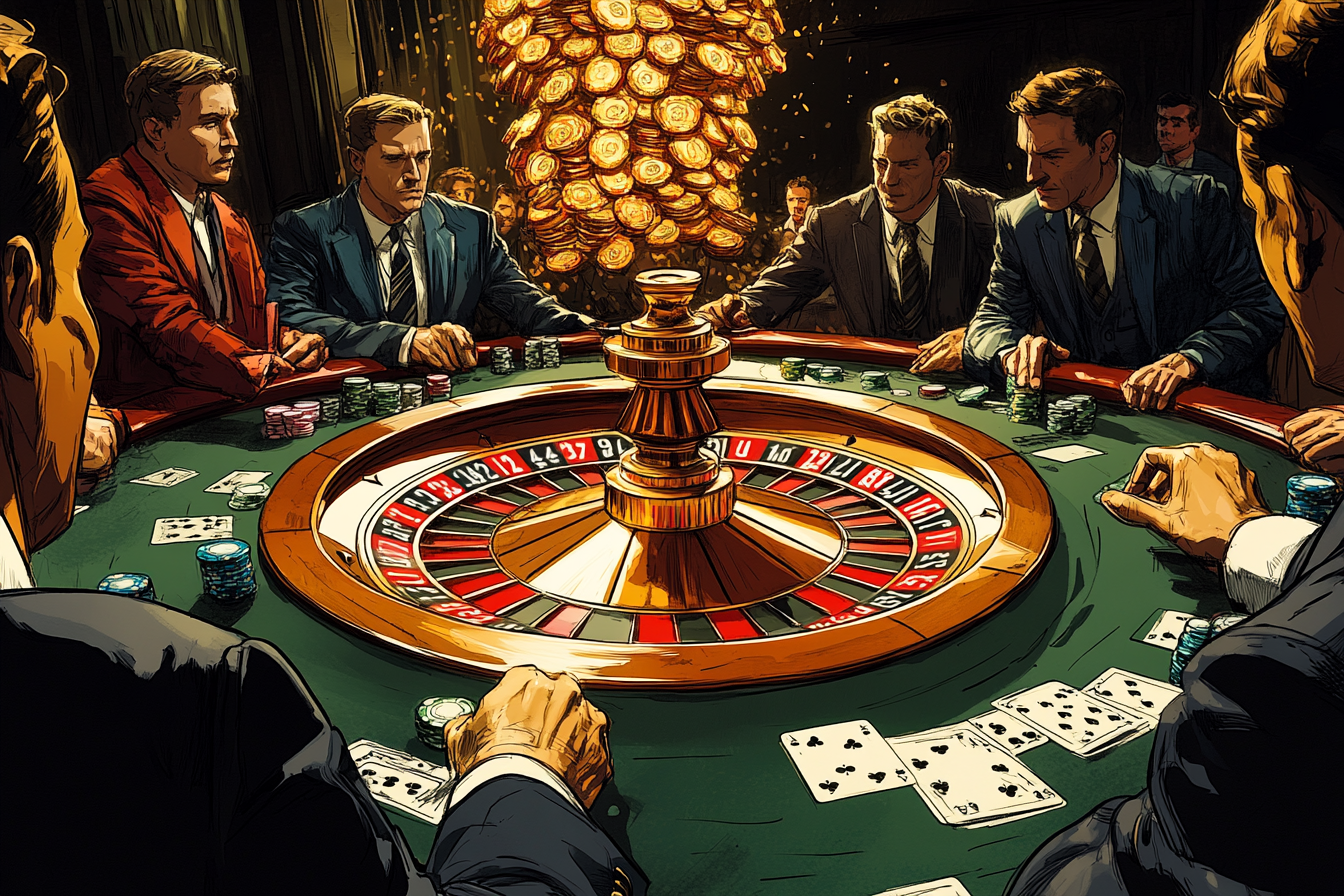The House Always Wins - Inside The Caesars Casino Financial Engineering Scheme
Uncover how Caesars used financial engineering to shield billions during bankruptcy. A deep look at corporate strategy, debt, and asset protection.
Author:Scarlet SunsetReviewer:Luna ShadowsongApr 14, 2025751 Shares16.6K Views

In the gambling world, the adage "the house always wins" refers to the mathematical edge casinos build into their games. But in the case of Caesars Entertainment, one of the world's largest gaming companies, the "house" wasn't just winning at the gaming tables; it was playing a far more lucrative game in the financial markets, with billions of dollars at stake.
The High-Stakes Acquisition
A $30.7 Billion Bet
In 2008, as casino revenues began feeling the impact of the Great Recession, private equity giants Apollo Global Management and TPG Capital placed a $30.7 billion bet on Harrah's Entertainment (later renamed Caesars Entertainment). This leveraged buyout used minimal equity, just $6 billion while loading the casino operator with a staggering $24.7 billion in debt.
Recession Hits Hard
The timing couldn't have been worse. As gamblers tightened their belts during the recession, Caesars' massive debt obligations became increasingly difficult to service. But rather than busting on this bad bet, the private equity owners devised a sophisticated strategy that would protect their investment while shifting the risk to creditors.
Splitting The Deck - The Asset Protection Strategy
Corporate Reorganization
Between 2009 and 2013, Apollo and TPG executed what many creditors would later call a "sleight of hand" worthy of the best casino magicians. They reorganized Caesars' corporate structure, dividing it into multiple entities:
- Caesars Entertainment Operating Company (CEOC)- Loaded with nearly all the debt ($18.4 billion)
- Caesars Growth Partners (CGP)- Housed the most valuable and promising assets
- Caesars Entertainment Resort Properties (CERP)- Contained additional protected assets
Moving The "Good Assets"
They transferred approximately $4.5 billion worth of prime casino properties including The Linq, Planet Hollywood, and Caesars' lucrative online gambling operations away from the debt-laden CEOC. These "good assets" were now safely beyond creditors' reach, while CEOC was left holding deteriorating casino properties and the crushing debt.
Collecting Chips From The Table
Profiting From The Restructure
While restructuring the company, Apollo and TPG didn't hesitate to cash in on their investment:
- They extracted approximately $180 million in management fees from the struggling casino operator
- They paid themselves roughly $350 million in transaction fees for various debt restructurings
- In 2013, they purchased approximately $950 million of Caesars' debt at steep discounts (40-60 cents on the dollar), positioning themselves advantageously for future restructuring negotiations
The Royal Flush - Pre-Bankruptcy Maneuvers
Shielding Key Assets
By 2014, it was clear CEOC couldn't sustain its debt burden. But before declaring bankruptcy, Caesars' owners made several critical moves:
- They transferred Caesars Interactive Entertainment (valued at $4.4 billion) beyond creditors' reach
- They eliminated approximately $700 million in guarantees from senior creditors
- Perhaps most importantly, they moved ownership of the Caesars brand itself and the valuable Total Rewards loyalty program (worth billions) into separate entities
Devaluing The Collateral
These assets the customer database, the brand recognition, the loyalty program represent the lifeblood of any casino operation. Without them, CEOC's physical casino properties were worth significantly less, effectively devaluing the collateral backing the debt.
Calling The Bankruptcy Bluff
Strategic Filing
In January 2015, CEOC filed for Chapter 11 bankruptcy with $18.4 billion in debt. The filing was strategic only CEOC entered bankruptcy while other Caesars entities holding the valuable assets remained protected.
Controversial Payout Offers
The initial restructuring offer gave senior creditors approximately 66 cents on the dollar, while junior creditors would receive less than 10 cents. Unsurprisingly, creditors cried foul, arguing that the asset transfers constituted fraudulent conveyances.
The Gaming Commission Investigates
The 4,700-Page Report
The bankruptcy court appointed independent examiner Richard Davis to investigate these transactions. His findings, detailed in a massive 4,700-page report, concluded there were potential fraudulent transfers worth between $3.6 billion and $5.1 billion a damning assessment that strengthened creditors' hands in negotiations.
Settling The Markers
Restructuring Deal
After two years of complex litigation, Apollo and TPG agreed to contribute approximately $5 billion to the restructuring plan. The final settlement allowed:
- CEOC to emerge from bankruptcy with about $10 billion in debt eliminated
- Senior creditors to receive approximately 66 cents on the dollar
- Junior creditors to recover approximately 34 cents on the dollar (significantly improved from the initial offer)
- Apollo and TPG to retain significant ownership in the reorganized company
Gaming The System - Legal Or Illegal?
The Gray Area
The Caesars restructuring operated in a legal gray area. While no court ever ruled the transactions illegal, the independent examiner's findings suggested they may have crossed lines. The case highlights how casino operators like their gambling customers often test the boundaries of what's permissible.
Key Ethical Questions
What Apollo and TPG executed was what bankruptcy experts call "liability management transactions" corporate restructurings designed to protect assets while managing debt obligations. These strategies, while technically legal when properly executed, raise serious ethical questions:
- Does current bankruptcy law properly protect creditor interests?
- Should private equity firms be allowed to extract substantial fees from failing companies?
- Do these financial engineering tactics undermine the integrity of credit markets?
Lessons From The Casino Floor
What Investors Should Watch
The Caesars case offers several insights for investors in casino operators and other highly-leveraged businesses:
- Watch for asset transfers - When casino companies begin moving properties between entities, it may signal preparation for restructuring
- Examine management fees - Substantial fees extracted during financial difficulty can indicate owners prioritizing their returns over company health
- Consider the true value of intangible assets - In the casino industry, brands, loyalty programs, and customer databases often exceed the value of physical properties
- Understand corporate structures - Complex organizational charts with numerous subsidiaries can facilitate asset protection strategies
The Aftermath - Caesars Today
A New Era After Restructuring
Ultimately, Caesars emerged from this restructuring as a lighter, more agile casino operator. In 2020, the company completed a merger with Eldorado Resorts in a $17.3 billion deal, creating the largest casino and entertainment company in the United States.
The Final Payoff
While the private equity owners eventually reduced their stakes, they did so after successfully protecting billions in value that might otherwise have gone to creditors. Their financial gamble on Caesars unlike most bets placed on casino floors paid off handsomely.
The Caesars case demonstrates that in the high-stakes world of casino financing, sometimes the most profitable game isn't found on the gambling floor but in the boardroom, where financial engineering can shift odds even more dramatically than any card counter or system player could dream of doing.
The Regulatory Response
Increased Scrutiny
Following the Caesars restructuring, gaming regulators in several jurisdictions have increased scrutiny of casino ownership transfers and corporate restructurings. Nevada, New Jersey, and other gaming authorities now require more detailed disclosures about debt structures and inter-company asset transfers when approving casino licenses and ownership changes.
Long-Term Consequences
For casino operators, the legacy of the Caesars case serves as both a warning and a playbook a reminder that while financial engineering can solve short-term problems, it can also trigger regulatory backlash and damage relationships with lenders critical to the capital-intensive casino business.
The Final Hand
In the end, the house may always win on the casino floor, but in the complex game of casino finance, determining who truly holds the winning hand is rarely as simple as counting chips.
Jump to
The High-Stakes Acquisition
Splitting The Deck - The Asset Protection Strategy
Collecting Chips From The Table
The Royal Flush - Pre-Bankruptcy Maneuvers
Calling The Bankruptcy Bluff
The Gaming Commission Investigates
Settling The Markers
Gaming The System - Legal Or Illegal?
Lessons From The Casino Floor
The Aftermath - Caesars Today
The Regulatory Response

Scarlet Sunset
Author
Scarlet Sunset is a captivating and confident transgender individual who radiates sensuality and embraces her unique beauty. With a radiant smile and a touch of red lipstick, she captivates hearts by the poolside as the sun dips below the horizon, casting a warm glow on her unforgettable presence.
Despite societal norms and expectations, Scarlet celebrates her body, proudly defying conventional standards of beauty. Her curves tell a story of self-acceptance and empowerment, challenging stereotypes and inspiring others to embrace their own bodies without reservation.

Luna Shadowsong
Reviewer
Luna Shadowsong, an enigmatic gambler shrouded in mystery, strikes a delicate balance between risk and darkness. With a muscular physique and intricate tattoos adorning her frame, she commands attention in the realm of chance and uncertainty. Behind her innocent gaze lies a seasoned gambler, who fearlessly embraces the exhilarating allure of high stakes. As she savors her cigarette, Luna's enigmatic presence draws others into her world of calculated risks and strategic maneuvers. Luna Shadowsong remains an enigma, whispered about in gambling circles, a symbol of fascination and unpredictable fortune.
Latest Articles
Popular Articles

